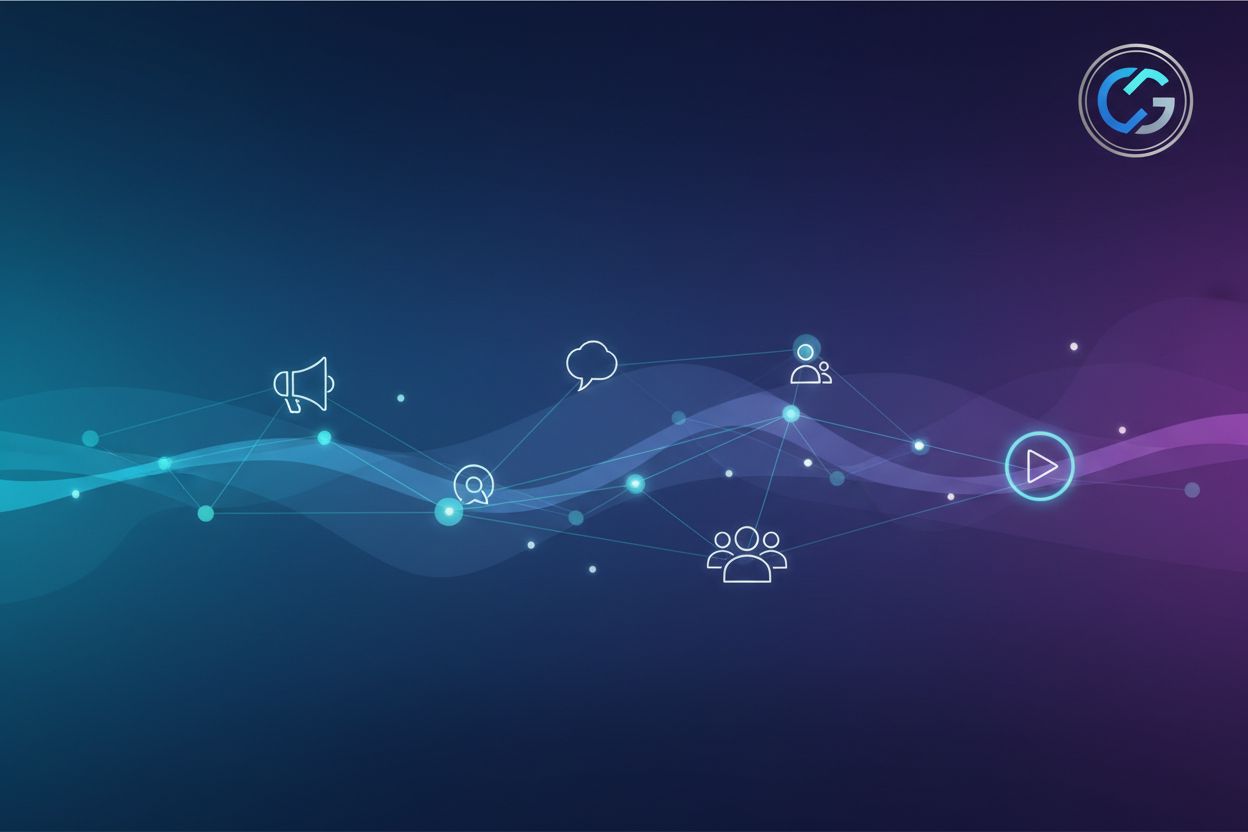AI-Enhanced Competitive Content Analysis: Dominate Your Niche
Introduction: The Competitive Content Landscape
Think about trying to figure out what's happening in a packed stadium by just peeking through a crack in the door; that's kinda like old-school content analysis. Nowadays, ai can help you see the whole stadium, like, instantly. (Generative AI and Real-time Data Transform Stadium Experiences)
Knowing what your competitors are up to is super important for good content marketing. It lets you:
- Get a handle on how competitors create and share their content. Knowing their moves helps you spot their strong and weak points.
- Find those content gaps and chances in your own area. If you see topics nobody's really covering, you can jump in and make content that people need.
- Keep up with what's trending and roll with the market changes. Watching competitor content keeps you in the loop on new stuff.
- Make your content work harder for you by focusing on what really matters to your audience. You can make sure your content efforts are aimed at what truly counts.
For instance, a healthcare place might look at what other providers are putting out to find missing bits in patient info, or a store could check out competitor sales to tweak their own prices.
The old ways of looking at content have some big problems:
- Doing it all by hand takes forever and costs a lot. (What Makes Manually Cleaning Data Challenging: Key Insights) Sifting through tons of content is a real slog.
- It's easy for your own opinions or biases to sneak in and mess up the results. (Bias in research - PMC) People doing the analysis might not even realize they're adding their own slant.
- It's tough to handle massive amounts of content data. Analyzing huge datasets is just too much for manual methods.
- You don't get fresh insights fast enough. Old methods often give you info that's already out of date by the time you get it.
Ai offers some pretty cool fixes for these issues:
- It automates collecting and analyzing data. Ai can grab and sort through huge amounts of content stuff without you lifting a finger.
- It's more accurate and less biased thanks to machine learning. Ai programs can cut down on bias and be more precise.
- It can find hidden patterns and insights you'd probably miss. Ai can uncover connections that humans might overlook.
- It lets you watch things in real-time and adjust your plans on the fly. Ai lets you keep an eye on things constantly and tweak your content plans as you go.
Ai tools, using Natural Language Processing (NLP), can dig through open-ended answers and interview notes, finding the common themes and feelings that tell you a lot about what people think Discuss.io.
As ai keeps getting better, the next part will dive into specific ai tools and methods that can really boost your competitive content analysis.
AI-Powered Tools for Competitive Content Analysis
Ai is totally changing how we look at content, giving us tools that find stuff out way faster and more accurately than before. But with so many options out there, how do you pick the right ones?
Publish7 has this SEO Strategy Generator that uses ai to whip up content marketing, seo, and link-building plans for free. This helps get more traffic, be seen more, and grow your brand. The tool checks out competitor keywords and content plans to find chances.
- It spits out practical seo tips based on what competitors are doing, helping you make your content better for search engines and climb up the rankings.
- Like, a small business could use this to see what keywords their rivals are ranking for and then make content that targets those same words.
Content gap analysis tools show you topics and keywords your competitors are covering, but you're not. These tools also uncover content styles and formats that your audience actually likes.
- They point out where you can offer something unique and show your expertise, helping you decide what content to make that'll have the biggest impact.
- For example, a finance company could use these to find out what they're missing in their content about retirement planning or investing, so they can create more focused and useful stuff for people.
Social media listening and analysis platforms keep an eye on what competitors are doing on social media and how people are reacting. They check out how people feel about brands and what they're saying, helping you find trending topics and conversations.
- These platforms give you the lowdown on competitor social media strategies, so you can adjust your own approach.
- For instance, a store could watch its competitors' social media to see which deals get the most people talking and then change its own marketing campaigns.
- According to insight7.io, looking at social media helps businesses understand their audience and get better at their strategies.
By using these ai-powered tools, marketers can get a real leg up on the competition. The next section will talk about ai-driven ways to make your content even better.
Key Features of AI-Enhanced Content Analysis
Did you know ai can sort through tons of data faster than you can make a coffee? Let's check out the main things that make ai-powered content analysis a total game-changer.
Ai is awesome at automating the boring parts of getting data. It uses web scraping to pull info from competitor websites and social media, grabbing stuff that would take humans ages to collect.
- Web scraping and data extraction from competitor sites and social media gives you a full picture of their content game. For example, ai can automatically grab all the blog posts, articles, and social media updates from a competitor's site.
- Automated content categorization and tagging sorts all this info, making it way easier to analyze. Ai can tag content by topic, keyword, and what kind of content it is.
- Natural Language Processing (NLP) lets it analyze text, finding key themes and feelings. Nlp programs can look at the words in competitor content to get what they're saying and their vibe.
- Integration with various data sources and APIs brings all your data collection into one place. Ai can pull info from lots of different spots, like Google Analytics, social media sites, and industry databases.
Ai programs can go deeper than just looking at keywords. Ai tools can now figure out the emotional tone of competitor content and how audiences are reacting.
- Figuring out the emotional tone and feelings in competitor content helps you see how their messages land. For example, ai can tell if a competitor's content makes people feel excited, trusting, or worried.
- Understanding how audiences react and what they think lets you see if competitor messages are actually working. Ai can analyze social media comments and reviews to see how people respond to different kinds of content.
- Spotting sarcasm, irony, and other tricky language makes sentiment analysis more accurate. Ai can pick up on subtle hints in text that people might miss, like sarcasm or irony.
- Gauging how well competitor messages are working helps you fine-tune your own content plan. By knowing how audiences react to what competitors put out, you can create content that connects better.
Ai can find new trends and topics in your industry super fast. It helps you stay relevant and adjust your content strategy accordingly.
- Finding emerging themes and topics in your industry helps you stay ahead of the game. Ai can look at industry news, social media chats, and competitor content to find trending stuff.
- Identifying content clusters and how topics relate shows you how different subjects are linked. Ai can group similar content together, helping you understand the bigger picture in your industry.
- Guessing future trends based on old data lets you get ready for what's coming. Ai can analyze past trends to predict what might happen next in your industry.
- Changing your content strategy to stay current makes sure your content stays interesting and effective. By knowing what's trending and what audiences like, you can make content that really connects with them.
Ai's ability to automate data gathering, analyze feelings, and spot trends gives you a big advantage in competitive content analysis. The next section will talk about ai-driven ways to make your content even better.
Step-by-Step Guide to Performing AI-Enhanced Competitive Content Analysis
Ready to turn your competitive content analysis from a drag into a real strategic win? Let's get into a step-by-step guide on how to use ai.
First, figure out what you want to achieve. What's the goal of your content analysis? Are you trying to understand competitor strategies, find content gaps, or stay on top of industry trends?
- Know your audience and what they need. Understanding your audience is like your compass for content. For example, a finance company aiming for millennials should focus on content about student loan debt and investment apps.
- Set clear goals for your content analysis. Do you want more website traffic, better search engine rankings, or more social media engagement? A healthcare provider might want to find gaps in patient education materials.
- Decide what you'll cover. Which competitors will you look at? What kinds of content (blog posts, social media updates, videos) will you include? Over what time period?
- Pick the right ways to measure if you're succeeding. This could be website traffic, social media interaction, keyword rankings, or getting leads.
Picking the right ai tools is key for analysis that's both efficient and accurate. Look for tools that can scrape websites, use nlp, and do sentiment analysis.
- Check out different tools based on what you need and what you can spend. A small business might go for a free seo strategy generator, while a bigger company might invest in a full social media listening platform.
- Think about things like where the data comes from, what features it has, and how easy it is to use. Some tools are great for social media data, while others focus on website content.
- Try out free trials or demos before you buy. This lets you see if the tool actually does what it says and if it's easy to use.
- Make sure the tools work with the marketing stuff you already use. Smooth integration makes your work easier and stops data from being all over the place.
Once you've gathered and analyzed the data, it's time to make sense of it and figure out what to do. Look for common themes, patterns, and trends in the data.
- Spot patterns and trends in the data. Ai can help you find hidden connections that you might miss if you're doing it manually.
- Figure out competitor strategies and what audiences like. What topics are your competitors talking about? What kind of content gets their audience excited? How do people feel about competitor content?
- Decide what content to create first based on what'll have the biggest impact. Focus on topics and formats that are likely to get the most engagement and the best results. This is where human smarts can really help ai out, like a Discuss.io article pointed out.
- Write down what you find and share it with your team. Make a report or presentation that sums up your main findings and what you suggest.
By following these steps, you can use ai to do competitive content analysis really well. The next section will talk about ai-driven ways to make your content even better.
Leveraging AI Insights to Improve Your Content Strategy
Ai insights can take your content strategy from a wild guess to a super focused effort. By using ai, you can make your current content better, create new content that fills in the blanks, and adjust your strategy based on what people are saying right now.
Ai can help you give your existing content a new lease on life. It finds keywords and topics that your audience is into, making sure your content is what they're looking for.
- Make content easier to read and more relevant: Ai tools look at content and suggest ways to improve the language, how it's put together, and how clear it is, making it more engaging and understandable. For example, a healthcare provider could use ai to simplify complicated medical terms in patient info.
- Add visuals and interactive stuff: Ai can spot chances to add in images, videos, and interactive elements, making it more engaging for users. A store could use ai to suggest adding product demos or customer testimonials to their product pages.
- Promote content the right way: Ai tools suggest the best places and ways to promote your content, getting it seen by more people. A finance company could use ai to figure out the best social media platforms to promote their retirement planning content.
Ai is great at finding content gaps and what's trending. It helps you create unique and valuable content that stands out from the rest.
- Find topics nobody else is covering: Ai tools point out topics and formats that your competitors aren't touching, showing you where you can offer something unique. A small business can use ai to find topics in their niche that aren't being covered well and create expert content to fill those gaps.
- Create content that's just right: Ai looks at audience data to make content that's specifically for their needs and interests, making it more engaging and relevant. For instance, a tech company can use ai to create personalized content experiences for different customer groups.
- Promote new content smartly: Ai-powered tools help you reach more people by finding the best ways and places to promote your new content. A marketing agency could use ai to make their content distribution strategy better and reach a bigger audience.
Ai lets you change things up in real-time based on what the audience is saying. It watches social media and online chats for mentions of your brand and competitors, giving you useful info on how people feel and what they're engaging with.
- Analyze feelings and engagement: Ai tools look at audience sentiment and engagement numbers, helping you understand how your content is being received. A store can monitor social media to get a sense of how customers feel about their latest product line.
- Make changes based on data: Ai helps you make data-driven changes to your content strategy based on real-time feedback, making sure your content stays relevant and works well. A finance company can adjust its content strategy based on audience feedback about their investment advice.
- Keep making content better: Ai makes it easier to constantly improve by finding areas to tweak and refine, ensuring your content meets what your audience needs as they change. A healthcare provider can use ai to keep improving their patient education materials based on what patients say.
By using ai insights, you can turn your content strategy into something dynamic and driven by data. The next section will talk about how to measure if your ai-enhanced content strategy is actually working.
Overcoming Challenges and Limitations of AI-Enhanced Content Analysis
Even though ai is really good at a lot of things, it's not a magic fix for content analysis. If you ignore the challenges and limits, you might end up with wrong conclusions and bad strategies.
One big thing is making sure the data is accurate. Ai needs good input data, so if the data is wrong or biased, the results will be messed up. Putting in place ways to check data quality is super important.
Another challenge is dealing with biases in ai algorithms. Ai models learn from data that might already have societal biases, which can mess up the analysis. Checking ai-generated insights with human smarts helps reduce these biases. Imagine a store using ai to analyze customer reviews; if the data mostly comes from one group of people, the insights might not represent everyone.
Keeping user data and privacy safe is a top priority. Being upfront about how you collect and use data is key to building trust with your audience.
It's also important not to use ai for tricking or misleading people. Following the right rules and guidelines makes sure you're using it ethically. A marketing agency, for example, needs to make sure that ai-driven content suggestions aren't misleading or taking advantage of people.
Ai has trouble understanding really complicated situations. Human judgment is needed to check and make sense of what ai comes up with.
Ai should make human expertise better, not replace it. Keeping a good balance between automation and human creativity makes sure your content analysis is well-rounded. A finance firm, for instance, can use ai to spot market trends, but human analysts need to understand these trends considering economic conditions and rules.
Knowing these challenges means you can use ai in content analysis responsibly and effectively. The next section will talk about how to measure if your ai-enhanced content strategy is actually working.
Conclusion: The Future of Competitive Content Analysis
The content world is always changing, but ai shows a clear way forward. By using ai-enhanced competitive content analysis, marketers can get a real advantage.
Ai's role in content marketing is only going to get bigger. Expect to see:
- More automation and personalization, letting you deliver content that's more targeted. For example, ai could automatically change blog posts to match what a reader has looked at before.
- Smarter nlp and machine learning programs, letting you get deeper insights into how audiences feel. Ai will get even better at understanding sarcasm.
- Connections with new data sources and platforms, giving you a more complete view of what competitors are doing. Imagine ai looking at data from new social networks to find trends.
- New ai-powered tools and solutions popping up, offering even more ways to improve your content strategy. The possibilities are endless.
To do well in the future, get on board with ai-powered tools and methods. This means:
- Staying ahead by using ai-powered tools and techniques. Be one of the first to try new tech.
- Making your content better, more relevant, and more engaging. Ai can help you create content that really connects with your audience.
- Making your content roi better and hitting your marketing goals. Ai can make sure your content efforts lead to real results.
- Building a data-driven way of thinking in your company. Encourage your team to use data and ai in their work.
Start your ai journey by trying out different tools and techniques. Remember to:
- Start small and experiment with different ai tools and methods. Don't try to change your whole strategy at once.
- Focus on solving specific business problems with ai. Pick projects that will clearly be valuable.
- Keep learning and adapting as ai changes. Stay up-to-date on the latest developments.
- Put data quality, ethical stuff, and human oversight first. Ai should make human expertise better, not replace it.
With these strategies, you can use ai to win in your niche. As Large Language Models (LLMs) get even more advanced, qualitative researchers are finding out how they can help with data analysis.





